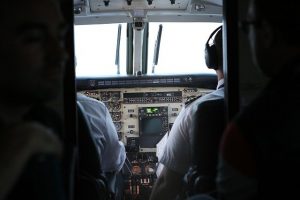 The cockpit is one of the most important parts of an airplane. Located within the nose, it contains an array of operational and communications control systems. Pilots will enter the cockpit where they are able to use these controls. While cockpits contain dozens of instruments, however, some are more important than others. There are six instruments of particular importance. Known as the “six pack,” they are found in the cockpits of nearly all airplanes.
The cockpit is one of the most important parts of an airplane. Located within the nose, it contains an array of operational and communications control systems. Pilots will enter the cockpit where they are able to use these controls. While cockpits contain dozens of instruments, however, some are more important than others. There are six instruments of particular importance. Known as the “six pack,” they are found in the cockpits of nearly all airplanes.
#1) Airspeed Indicator
One of the instruments in the six pack is the airspeed indicator. It’s the equivalent of a speedometer for airplanes. The airspeed indicator shows how fast the airplane is moving through the air. In most cockpits, the airspeed indicator is found in the upper-left corner of the six pack instrumental panel.
#2) Altitude Indicator
Next to the airspeed indicator is the altitude indicator. Also known as the artificial horizon, it shows the orientation of the airplane. Pilots can check the altitude indicator to determine whether they are flying parallel to the Earth’s, or if not, the degree to which they are not.
#3) Altimeter
Another instrument in the six pack is the altimeter. The altimeter reveals the airplane’s altitude. It specifically shows the height at which the airplane is flying above mean sea level. In most airplane cockpits, the six pack consists of two rows with gauges each. The altimeter is the last gauge on the far right side of the top row.
#4) Vertical Speed Indicator
There’s also the vertical speed indicator. It’s similar to an airspeed indicator, except it shows the speed at which the airplane is ascending or descending. Pilots use it to ensure that they aren’t ascending or descending too quickly.
#5) Heading Indicator
Within the six-pack is a gauge consisting of a magnetic compass. Known as the heading indicator, it shows the direction in which the airplane is flying. Airplanes, of course, are affected by the wind. Even if an airplane is pointing in the right direction, a strong gust of wind may change its trajectory. The heading indicator allows pilots to maintain the appropriate trajectory so that they stay course.
#6) Turn Coordinator
Finally, there’s the turn coordinator in the six pack. It’s designed to assist pilots with turning the airplane. The turn coordinator contains two parts. One of the parts shows the airplane’s rate of turn. The other part shows the slip or skin of the airplane’s turn.



